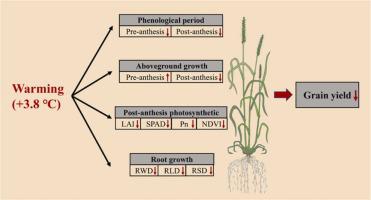Field Crops Research ( IF 5.6 ) Pub Date : 2022-04-21 , DOI: 10.1016/j.fcr.2022.108545 Gong Wu 1 , Jun Ling 1 , Zi-Xi Liu 1 , Yi-Ping Xu 1 , Xian-Min Chen 1 , Yuan Wen 1, 2, 3 , Shun-Li Zhou 1, 2, 3

|
Soil temperature rise caused by global warming is one of the most serious threats to crop physiology and production. Straw return is considered as a potential strategy to improve soil health and agricultural productivity. However, little is known about their interactive effects on wheat growth and production, which limits the development of strategies and technological innovations for future food security. Therefore, in the two wheat seasons from 2018 to 2020, with or without straw return, the heating cable was laid at a depth of 20 cm to increase the soil temperature by 3.8 ℃, and the phenology, photosynthesis, root growth, and grain yield of winter wheat were studied. Soil warming advanced the anthesis date by one week and promoted pre-anthesis wheat growth and dry matter transportation. However, soil warming decreased post-anthesis duration, leaf area index, SPAD, net photosynthesis, and spectral vegetation indexes. Therefore, post-anthesis dry matter accumulation and grain filling were inhibited, lowering the 1000-grain weight and harvest index. Furthermore, the post-anthesis root weight, length, surface area densities and root to shoot ratio were also decreased under soil warming. Finally, soil warming reduced the grain yield by 35.2% in the dry 2018–2019 year. However, the wheat growth characteristics were considerably higher and no difference in grain yield was detected among treatments in the wet 2019–2020 season, indicating that increased precipitation may offset the adverse effect of soil warming on wheat yield. Straw return increased aboveground biomass, but had no effect on wheat yield, probably because the positive effects were limited in the short experimental duration. The findings suggested that soil warming would promote pre-anthesis wheat growth but accelerate post-anthesis wheat senescence, affect dry matter transportation and accumulation, eventually reducing wheat yield in the NCP, especially under dry condition.
中文翻译:

土壤变暖和秸秆还田对华北平原冬小麦物候、光合作用、根系生长和粮食产量的影响
全球变暖导致的土壤温度升高是对作物生理和生产的最严重威胁之一。秸秆还田被认为是改善土壤健康和农业生产力的潜在策略。然而,人们对它们对小麦生长和生产的交互影响知之甚少,这限制了未来粮食安全战略和技术创新的发展。因此,在 2018-2020 年的两个小麦季节,无论有无秸秆还田,加热电缆铺设深度 20 cm,使土壤温度升高 3.8 ℃,物候、光合作用、根系生长和籽粒产量研究了冬小麦。土壤变暖使开花期提前一周,促进了开花前小麦的生长和干物质运输。然而,土壤变暖缩短了开花后的持续时间,叶面积指数、SPAD、净光合作用和光谱植被指数。因此,抑制了花后干物质积累和籽粒灌浆,降低了千粒重和收获指数。此外,在土壤变暖的情况下,开花后根的重量、长度、表面积密度和根冠比也降低了。最后,土壤变暖使 2018-2019 年干旱年份的粮食产量减少了 35.2%。然而,小麦的生长特征明显更高,并且在 2019-2020 年湿季处理之间未检测到谷物产量差异,表明降水增加可能抵消土壤变暖对小麦产量的不利影响。秸秆还田增加了地上生物量,但对小麦产量没有影响,可能是因为积极影响在较短的实验持续时间内受到限制。











































 京公网安备 11010802027423号
京公网安备 11010802027423号